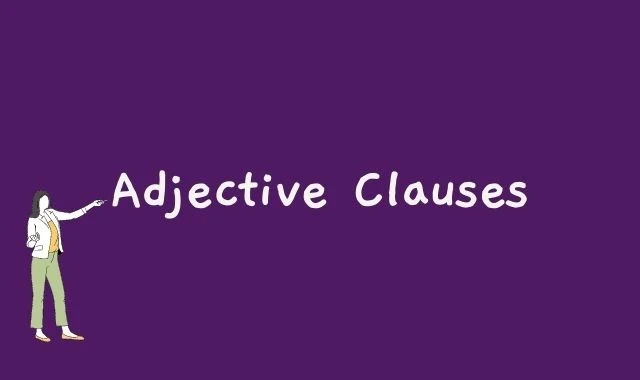Adjective Clauses
Introduction
Imagine reading a story that paints a vivid picture in your mind, rich with details that bring every scene to life. What if I told you that mastering adjective clauses could help you achieve this level of descriptive writing? Whether you're a student aiming to elevate your grammar grammar skills or a writer looking to add depth to your prose, understanding adjective clauses is a game-changer. In this article, "Adjective Clauses," we'll explore how these powerful subordinate clauses can modify nouns and pronouns, making your sentences more descriptive and engaging. Let's dive in and discover the magic of adjective clauses to transform your writing!
Remember!
Adjective Clauses
Adjective clauses usually follow the noun or pronoun they modify. They describe nouns or pronouns, adding interesting details to sentences by telling what kind or which one.
EXAMPLES
- Felicia’s house, which is the red brick one on the corner, is shaded by pine trees. [The adjective clause follows the noun it modifies, house, and describes it, telling which house it is.]
- The shade that moves across her yard each day allows her little brothers to play outside comfortably. [The adjective clause follows the noun it modifies, shade, telling what kind of shade.]
NOTE
An adjective clause usually begins with a relative pronoun, which shows the relationship of the clause to the word or words it modifies.
Common relative pronouns include that, which, who, whom, and whose.
An adjective clause may also begin with a relative adverb, such as when or where.
Common relative pronouns include that, which, who, whom, and whose.
An adjective clause may also begin with a relative adverb, such as when or where.
Essential and Nonessential Adjective Clauses
Adjective clauses come in two types, depending on what they do in a sentence.
An essential (or restrictive) clause is critical to the meaning of the sentence.
An essential clause restricts the meaning of the noun or pronoun it modifies.
If you remove an essential adjective clause from the sentence, the sentence loses part of its basic message and may not make sense at all.
An essential (or restrictive) clause is critical to the meaning of the sentence.
An essential clause restricts the meaning of the noun or pronoun it modifies.
If you remove an essential adjective clause from the sentence, the sentence loses part of its basic message and may not make sense at all.
ESSENTIAL
- Avoid exercises that cause you pain. [Without the essential clause, the sentence would read, “Avoid exercises.” The essential clause restricts the meaning of exercises. Not all exercises should be avoided, only those that cause you pain.]
A nonessential (or nonrestrictive) clause, on the other hand, adds additional information to a sentence.
Removing a nonessential clause from a sentence makes the sentence less specific or less interesting, but it does not change the basic meaning of the sentence.
Because nonessential clauses can be removed from the sentence in this way, these clauses are separated from the sentence by commas.
Removing a nonessential clause from a sentence makes the sentence less specific or less interesting, but it does not change the basic meaning of the sentence.
Because nonessential clauses can be removed from the sentence in this way, these clauses are separated from the sentence by commas.
NONESSENTIAL
- A weight bar, to which weights can be added, should carry just enough weight to challenge your muscles. [The adjective clause adds a detail about a weight bar that is interesting. However, if you remove the clause, the sentence’s basic meaning stays the same: “A weight bar should carry just enough weight to challenge your muscles.”]
Adjective Clauses Quiz
Conclusion
Mastering adjective clauses can significantly enhance your grammar and vocabulary skills, allowing you to add depth and detail to your writing. By understanding how to use these clauses effectively, you can create more vivid and engaging sentences. Keep practicing, and don't hesitate to revisit this guide whenever you need a refresher. Remember, the key to mastering grammar is consistent practice and application. Happy writing, and may your sentences always be rich and descriptive!
FAQs:
Q: What is an adjective clause?
A: An adjective clause is a dependent clause that functions as an adjective by modifying a noun or pronoun. It describes, identifies, or gives further information about a noun.
Q: How do you identify adjective clauses?
A: Adjective clauses usually start with words like "that," "which," "who," or "whose." They provide more details about a noun or pronoun in the sentence.
Q: Where do adjective clauses go in a sentence?
A: Adjective clauses follow the nouns they modify. For example: "The house that stands on the corner is green."
Q: What’s the difference between adjective clauses and relative clauses?
A: There is no difference. Adjective clauses and relative clauses modify a noun and function as adjectives. The terms can be used interchangeably.
Q: How do adjective clauses differ from adjectives?
A: Adjectives provide details about nouns, while adjective clauses provide even more descriptive details as a clause with a subject and verb.
References
- The Blue Book of Grammar and Punctuation, 11th Edition by Jane Straus, Wiley, 2014.
- "Adjective Clauses" from Grammar Monster: https://www.grammar-monster.com/glossary/adjective_clauses.htm
- "Adjective Clauses" from Grammar.com: https://grammar.yourdictionary.com/parts-of-speech/adjectives/adjective-clause.html


